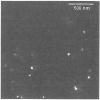Near-field scanning optical microscopy for high-resolution membrane studies
- PMID: 23086886
- PMCID: PMC3535274
- DOI: 10.1007/978-1-62703-137-0_21
Near-field scanning optical microscopy for high-resolution membrane studies
Abstract
The desire to directly probe biological structures on the length scales that they exist has driven the steady development of various high-resolution microscopy techniques. Among these, optical microscopy and, in particular, fluorescence-based approaches continue to occupy dominant roles in biological studies given their favorable attributes. Fluorescence microscopy is both sensitive and specific, is generally noninvasive toward biological samples, has excellent temporal resolution for dynamic studies, and is relatively inexpensive. Light-based microscopies can also exploit a myriad of contrast mechanisms based on spectroscopic signatures, energy transfer, polarization, and lifetimes to further enhance the specificity or information content of a measurement. Historically, however, spatial resolution has been limited to approximately half the wavelength due to the diffraction of light. Near-field scanning optical microscopy (NSOM) is one of several optical approaches currently being developed that combines the favorable attributes of fluorescence microscopy with superior spatial resolution. NSOM is particularly well suited for studies of both model and biological membranes and application to these systems is discussed.
Figures












Similar articles
-
Scanning near-field optical microscopy of a cell membrane in liquid.J Microsc. 2003 Jun;210(Pt 3):288-93. doi: 10.1046/j.1365-2818.2003.01147.x. J Microsc. 2003. PMID: 12787101
-
Near-field scanning optical microscopy: a tool for nanometric exploration of biological membranes.Anal Bioanal Chem. 2010 Jan;396(1):31-43. doi: 10.1007/s00216-009-3040-1. Anal Bioanal Chem. 2010. PMID: 19730836 Review.
-
Scanning near-field fluorescence resonance energy transfer microscopy.Biophys J. 1999 Apr;76(4):1812-8. doi: 10.1016/S0006-3495(99)77341-8. Biophys J. 1999. PMID: 10096880 Free PMC article.
-
High-resolution near-field optical imaging of single nuclear pore complexes under physiological conditions.Biophys J. 2005 May;88(5):3681-8. doi: 10.1529/biophysj.104.051458. Epub 2005 Feb 4. Biophys J. 2005. PMID: 15695631 Free PMC article.
-
Life on biomembranes viewed with the atomic force microscope.Wien Klin Wochenschr. 1997 Jun 27;109(12-13):419-23. Wien Klin Wochenschr. 1997. PMID: 9261980 Review.
Cited by
-
Uncovering the cytotoxic effects of air pollution with multi-modal imaging of in vitro respiratory models.R Soc Open Sci. 2023 Apr 12;10(4):221426. doi: 10.1098/rsos.221426. eCollection 2023 Apr. R Soc Open Sci. 2023. PMID: 37063998 Free PMC article. Review.
References
-
- Betzig E, Chichester RJ. Single molecules observed by near-field scanning optical microscopy. Science. 1993;262:1422–1425. - PubMed
-
- Betzig E, Isaacson M, Barshatzky H, Lewis A, Lin K. Near-field scanning optical microscopy (NSOM) Proc SPIE-Int Soc Opt Eng. 1988;897:91–99.
-
- Betzig E, Trautman JK. Near-field optics: microscopy, spectroscopy and surface modification beyond the diffraction limit. Science. 1992;257:189–195. - PubMed
-
- Buratto SK. Near-field scanning optical microscopy. Curr Opin Solid State Mater Sci. 1996;1:485–492.
-
- Dickenson NE, Armendariz KP, Huckabay HA, Livanec PW, Dunn RC. Near-field scanning optical microscopy: a tool for nanometric exploration of biological membranes. Anal Bioanal Chem. 2010;396:31–43. - PubMed
Publication types
MeSH terms
Substances
Grants and funding
LinkOut - more resources
Full Text Sources

